Utopian communities are efforts to put theory into practice.
I made another field trip to utopia.
This time I went to the Tennessee State Library and Archives in Nashville. I spent a week there, examining material in the Reading Room and doing something I said to myself when I finished the dissertation that I would never do again. What is that, I hear you ask? Reading microfilm. How did I come to be there? And why microfilm? For the answer to these and other questions read on.
Tennessee had three noteworthy utopian communities: Ruskin, Nashoba, and Rugby. The first is the most interesting and the only one that meets a definition of utopian. Nashoba is certainly remarkable but not as utopia. Rugby has neither claim. I knew that these had existed and had read something about each of them at one time or another.
Then when thinking about revisiting some spots in Iowa (Amana, Corning, and Buxton) that I have yet fully to mine, I did a google search, and discovered that the Tennessee State Library and Archive had an exhibit on the three Tennessee communities (and a fourth with even less claim to be taken seriously than Rugby). Ah, the miracles of the web.
http://www.state.tn.us/tsla/exhibits/utopia/index.htm
There was curator’s name associated with the exhibit and an email address, so I asked about it. He replied and one thing led to another.
Here I am 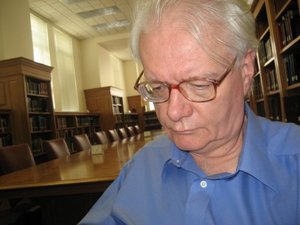
studiously reading the reading room. My self photographs are not very flattering are they? As you can see, no one else about. I pretty much had the place to myself. A few other readers came and went and they seemed mostly to be searching family genealogy. When I hear that I always suspect the worst – Mormons! I found several theses and some department papers form Sociology at the University of Tennessee. These I read. Very much products of their times, the ones from the 1930s were all for planning and social engineering and those from the 1950s were worried about the red menace. I also found a map, thanks to the curator, of some utopian communities in an atlas of American history that was new to me. It too is a curiosity.
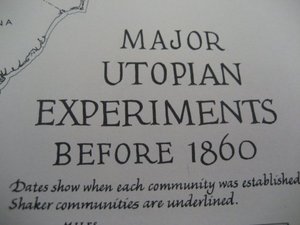
It is a peculiar map that includes some communities and not others and seems weighted to the Shakers. There is no explanation of the criteria or purpose of the map in the volume. Strange. I am going to follow-up on this by looking at the first edition.
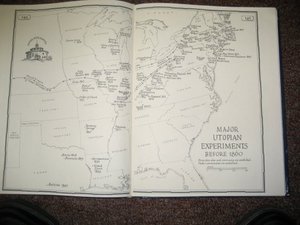
This is a photograph not a photocopy. I was feeling lazy and did this at the table rather than get change for the copier.
I said two of the communities were not utopian. That begs the question, what do I mean by ‘utopian?’ A utopian community is one that tries to put theory into practice by organizing a community along preordained lines. It is not just any community and not just any community with the aim of a better life, but one that is inspired to a complete vision known in advance (the theory). Ruskin (named for the English aesthete John Ruskin because of his anti-materialist orientation, though he personally had nothing to do with it) was derived from the tenets of Christian Socialism, a movement long since forgotten. On Ruskin see http://en.wikipedia.org/wiki/John_Ruskin This is the same Ruskin whom Marcel Proust credits as his inspiration. It had its moment at the end of the 19th Century. Horticulturist take note, it was at Ruskin that Dr Walter van Fleet developed the rose which he named for his wife, Sarah, and which is still to be found, as the van Fleet rose. http://www.classicroses.co.uk/roses/d/dr_van_fleet.html Alas on this web site it is named for the Dr and not for Sarah.
The Library and Archive had all manner of paraphernalia from these communities and I examined a lot of it, vertical files (boxes in library lingo), and microfilm, including a ten pages typescript by one resident of Ruskin entitle “The happiest years of my life.” The title is touching and that inspired me to read it with care, even though it was on microfilm, but nothing in the text explains why those years were so good. By the way the Library and Archive possesses this typescript in the original but I was not permitted to examine it. I had to settle for the microfilm, so whatever spirit might have been communicated by touching it I did not get. As I said when told this, the Tennessee State Library and Archive takes better care of its collection than the British Library does, where I am regularly surprised, pleased, and worried to have rare first editions from the 16th and 17th Century entrusted to me the Rare Books Reading Room. Is it my honest face? Well that did not cut it in Nashville.
At about the same time, Rugby was a settlement intended to offer second and later sons of the English landed classes the chance for a new life in America since they could not by the law of primogeniture inherit the family estate. There was nothing systematic about its approach to making this new life. The only theoretical base was the assumption that an English public school education somehow equipped a gentlemen to cope. It did not. It was accordingly named for one of those public schools: Rugby. Some of the buildings remain and someone has made an effort to turn it into a tourist site. http://www.historicrugby.org/ It is near Knoxville and off a paved road; I estimated it to be three hours there and three more back. Seemed a lot of driving for little return so I passed this time. I felt confident in this estimate after finding in the Archive and Library a promotional video and watching it, thanks to the industry and flexibility of the librarian who set it up for me, Gwyn Thayer. Maybe another time.
Nashoba is the most curious. It existed for a few years around 1825. A wealthy and independent women named Fanny Wright bought the land along the Wolf River in what is now Germantown (south Memphis) Tennessee. She proposed a racially integrated community in which freed slaves would learn to live freely. That certainly sounds good if a century ahead of its time, but apart from buying the land and the slaves, she had no plan or purpose to obtain that end. To this jaundiced eye, it seems rather like those celebrities today who think they are changing the world by adopting an African orphan. Wright was indeed something of a celebrity of her day and figures in Fanny Trollope’s Domestic Manners of the Americans (1827) as such. Wright grew bored with life on the Tennessee escarpment in less than a year and went back to what she did most and best, traveling. I stayed in Germantown while at a conference in Memphis a few years earlier and found not one trace of the Nashoba community.
What I did find and find remarkable was the Nashoba is publicly remembered in Nashville. Between the state capitol and the river is the Capitol Mall. Put away your Mastercard, it is not that kind of mall. It is a park that records Tennessee history and it is definitely worth strolling through, though the day it did it, an August morning before 8 a.m. it was hammeringly hot. Tennessee, as border state like Virginia, was hard fought over in the Civil War and that is present in his mall, the list of bloody battles is numbing: Fort Pillow, Fort Donelson, Fort Henry, Shiloh, Chattanooga, Chickamauga, Franklin, Missionary Ridge, and others. Nashoba seems an unlikely inclusion is such hallowed company as that, but at the front entrance to the park there is a water feature, and since it was blindingly hot already my feet took themselves up close to it 
where I saw amid the sparse commentary on the fountain which features Tennessee’s many rivers (Mississippi, Tennessee, Ohio, Wabash, the list goes on to thirty-five) is a line about Nashoba.
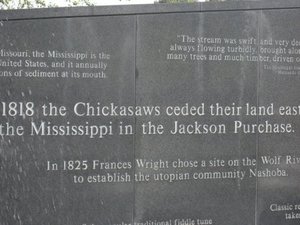
How strange for this ephemeral event to be noted here. I puzzled over it and came to no conclusion. Yes, I did ask in the Library and Archive and tried to find out but to no avail. By the time I made it back up the hill and into the Library and Archive it was 100F (40C) at 9:15 a.m. It got hotter that day. I skipped lunch and stayed in the air conditioned and shaded reading room. When this park was planned for the state’s bicentenary some Fanny Wright fans had a win. That make it the only so-called utopian community to be those commemorated in stone by a state government that I have seen.
While I was in Nashville, well in fact, when I was leaving, I drove to the Parthenon. Yep. There is a full sized replica of that famous Greek building in Nashville, build to symbolize Nashville’s commitment to enlightenment, learning, and education on the occasion of the state’s centenary. Snobs may sneer at this but let me think, when did an Australia state last embody its belief in the value of the mind? Take that as a question on notice.
It is something, this Parthenon. 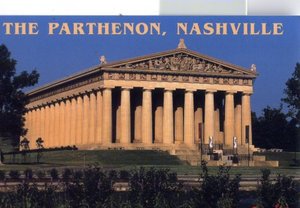
I got there about 9 a.m. and the place to myself for the time I was there. In the main gallery is a replica of the 41 foot tall statue of Athena that Pheides placed in the Parthenon. The picture does not do it justice. 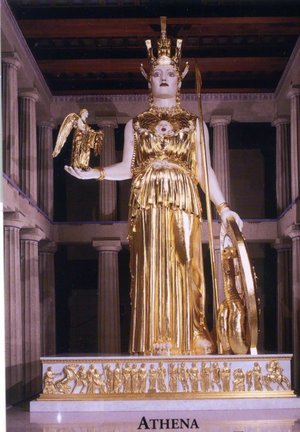
Standing in front of it I came up to about the middle of the frieze.
Well I hope to visit Athens later this year and see what is left of the original, and this seemed a welcome portent of that visit.
I also took advantage of this trip to visit Oxford Mississippi, a place I have wanted to make a pilgrimage to for years. You, too, probably. Why? Oh, well because William Faulkner lived his days there and wrote those Yoknapatawpha County novels there. If you don’t know Faulkner’s work, you should, and the easiest place to start is either The Bear or Intruder in the Dust, though his most outstanding and astounding novel is Absalom! Absalom!, but it is much less reader-friendly than the first two. He thought, I know now from visiting Oxford, his best book, ‘my little gem’ he said of it, was The Sound and the Fury. I could go on about Faulkner, but with great restraint I shall not. Suffice it to say his novels remain life long companions. Neophytes might start here http://www.mcsr.olemiss.edu/~egjbp/faulkner/faulkner.html
While traveling I noticed ANOTHER ACCOLADE FOR JACKSON
In USA Today of 10 August 2007 on page 14D I read an uncredited piece called “Spain’s fine Albariños deserve a closer look.” It opened with this paragraph:

Bow I did. Yes, I did and lot sooner than 2007, say about 2002 when I started on the rosé road.
I also paid a visit to home and hearth.
I made many insightful observations along the way (say on the straw voting in Iowa while I was in Des Moines) but I do not include them all here least some self-appointed censor for the University take offense, again.
By the way, I am sometimes asked why I bother to visit utopian sites like Amana. There are many answers. On occasion one finds materials there not otherwise to be found. Furthermore, being there also gives one a sense of the scale, durability, and location of the place that no reading can offer. Relying completely on the written accounts is rather like a sports fan who follows a sport, pick one, only from the newspaper accounts. There is still more to be gained for this sports fan to watch a game on television, the better to understand how the ebb and flow of the game goes. Even better is to attend a game in person to get a sense of the occasion through, in part, how the other fans act. So for me, a field trip like this is a little bit like going to a game is for a sports fan. It brings home the reality ever more than reading can.
In the interests of flexibility I choose to drive this time rather than fly around. While I grew weary of the driving on my own, when I read about the bursting at the seams summer air traffic (with the associated delays, break downs, lost luggage) in the States I felt better about it.
Rest easy taxpayers. All expenses for this trip were funded by my earnings.

I would have writtenerlier, but I ws busy taking many bows for having discovered rose wine during my long-ago undergraduate days. Haven’t tried it since.
A question: Did the Shakers really prach sexual abstinence? What was their succession plan?
Hi Michael,
I was fortunate enough to take your Utopia course and these posts will always be of special interest.
If anything, blogs like this(I mean that in the nicest possible way) make the academic world more accessible. I think this kind of accessibility is what students need; to see your thought process and the steps you go through to gather information. To use your sports analogy, if a kid wants to be a better player, it might be good to study the player’s moves, but surely it is better to also understand the training and practice techniques that the player uses. Maybe I have missed the mark but so often students are told to write, or how to write, a paper. Learning about the process and ways to think about the process, on the other hand, is something I think is neglected by some.
You say — “Horticulturist take note, it was at Ruskin that Dr Walter van Fleet developed the rose which he named for his wife, Sarah, and which is still to be found, as the van Fleet rose. http://www.classicroses.co.uk/roses/d/dr_van_fleet.html Alas on this web site it is named for the Dr and not for Sarah.”
Alas, that website is correct. There are two quite different roses involved here: the Wichurana Rambler ‘Dr Van Fleet’, introduced in 1910, and the Rugosa hybrid ‘Sarah van Fleet’, introduced in 1926. Both were indeed raised (along with some 20 others) by Walter Van Fleet (1857-1922) while he was working for the USDA , which he joined in 1891. (Any of them could be described “a Van Fleet rose”; it is misleading to speak of “THE Van Fleet rose” as though he only raised one.) Notice that ‘Sarah van Fleet’ was named and introduced posthumously. I think you will find he had left Ruskin and was living in Maryland by the time he started breeding roses.
Many thanks for the correction. Michael
Hi Michael,
I think this kind of accessibility is what students need; to see your thought process and the steps you go through to gather information.
Bets wishes.
Isyeri
Hi Michael,
Thanks for this blog and your work.
Can you tell me what communities were missing from that map you photographed here? I am using it and would like to understand its deficiencies.
Thanks!
Thanks for the post. I will follow-up now that I have these basic points in mind. Betty